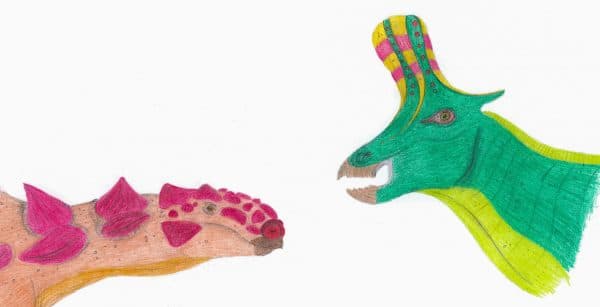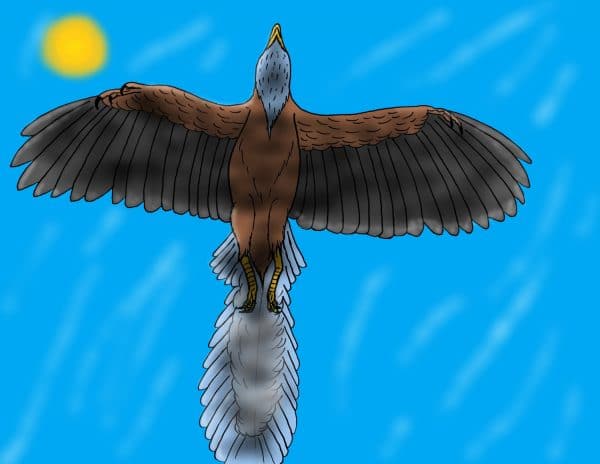
Looking at a dinosaur skeleton in a museum display mount or its isolated bones in a collections drawer, it can sometimes be hard to think of these animals as living creatures. Individual beings who had lives, motives, and interactions with each other. So much of paleontology focuses on fossil animals separate from the world they lived in, and paleontologists are cautious of assuming too much about the activities of creatures they can’t observe in life.
But of course, dinosaurs were once living, breathing animals, and must have communicated not only within their own species, but with other animals, dinosaurian and otherwise, that they shared their ecosystems with. It’s always guesswork to speculate on the behavior and lifestyle of extinct animals, but using what we know about dinosaur biology we can make sure our guesses are fairly grounded in what was, if not probable, at least possible.
So how did dinosaurs communicate with each other? Pop culture would have us believe that dinosaurs spent nearly every waking minute of their day stomping around and screaming their heads off at each other with teeth/claws/horns bared and ready. Real animals are hardly ever this one-dimensional, even ones as superlative as dinosaurs, who almost certainly were not going around roaring and bellowing at each other just for the sake of it. Chances are that, unless they had something specific to say, dinosaurs were probably silent.
One way that dinosaurs almost certainly communicated messages of some sort to each other was through visual displays. Like most sauropsids (‘reptiles’ and birds), dinosaurs were probably very vision-oriented animals, able to see colour and shapes better than we simple mammals can. While many dinosaurs, especially prey species, had eyes on the sides of their heads to better see all around them, predatory dinosaur eyes often faced somewhat forwards like ours do (Stevens, 2006). This is was brought to the extremes in species like Tyrannosaurus, which had huge eyes that faces directly forwards and were capable of rapid movements (Witmer & Ridgely, 2009). This, combined with big optic lobes in the brain, gave Tyrannosaurus vision comparable to modern birds of prey.
It’s not unreasonable to think that body language- posturing and posing- played some role in the communication of dinosaurs. A look at the behaviours of modern birds supports this, and each species has its own little posturing quirks. Sharp-tailed grouse perform intricate dances with heads down and tails skyward, hummingbirds swoop and duck in the air, goldeneyes jerk and bob their heads, and countless tropical songbirds have mastered complex and intricately choreographed dance numbers. Birds move, pose, and contort themselves in countless ways, whatever it takes to catch the eye of a potential mate of scare off an unwanted rival. There is some fossil evidence of dinosaur courtship in the literature to support this, such as a 2016 study reporting fossilized scratch-marks from large theropods engaging in some sort of display ceremony (Lockley et al., 2016).
With a sharp sense of full-colour vision, the possibilities for how dinosaurs could have shown off to each other are nearly endless. Some classic examples of dinosaur display gear are the weird bony ornaments of big plant-eaters. The crests of hadrosaurs and the frills and horns of ceratopsians spring to mind for most people. Features like these are fairly honest signals of fitness in animals- you can’t grow the biggest crests, horns, or spikes without having good genes, and that’s what female animals typically look for. Even the relatively beady-eyed ankylosaurs would show off to each other. The spines of the stupendously preserved Borealopelta indicate their use as display features within that species as well as use as defensive weapons (Brown, 2017). The plates of stegosaurs, with their long-debated function ranging from a protective shell to gliding airfoils (look it up, it’s hilarious), are now thought to perhaps have been differently shapes in males than in females, serving as a broad, colourful display structure in the males (Saitta, 2015). Perhaps things like the bony crests of hadrosaurs or the spiked frills of ceratopsids were also brightly coloured in life to really make these features stand out. We don’t know for sure yet, but I wouldn’t be surprised if it was true.

Stegosaurus making sure its plates are nice and visible to potential mates. By Nicholas Carter
Feathers were almost certainly used for visual displays as well. Countless birds today use their colourful and elaborate feathers to show off to each other, and use in display is thought to perhaps have been a driving force in the evolution of complex feathers. Many feathered dinosaurs, such as the maniraptoran theropods, had long feathers on their forearms that essentially formed wings. Unable to use them for flight, perhaps these simple ‘wings’ were used as display features. Many of today’s birds flare their conspicuous wing feathers as a sign of readiness to breed or as a form of intimidation to rivals and predators, so non-avian dinosaurs with the same gear probably did so too. Numerous modern birds also have very colorful feathers, especially the males on whom the burden of showing off is most often thrust on. Think of the colourful plumage of male ducks, gamebirds, and exotic wonders like the birds of paradise in New Guinea. While we have a very modest knowledge of dinosaur colouration, we’ve got some examples of species that might have used some simple colouration to send some kind of message. The small birdlike Anchiornis, for example, is known to have had vivid red crown of feathers, with rufous speckles around the face and contrasting black and white patterns on the wings (Li et al., 2010). Caihong, a close relative of Anchiornis, was found to have had shiny, iridescent feathers similar to the trumpeter birds of South America, perhaps also serving as a display feature (Dongyu et al., 2018). We can’t observe Anchornis and Caihong in life to see for sure if this is what their colours were used for (assuming they were ‘for’ anything) but some kind of display isn’t an unreasonable idea.

The oviraptorid Citipati with feathers spread performing a courtship ritual. By Nicholas Carter
There’s also endless possibilities for soft-tissue structures in dinosaurs that we might never be able to know of, but could have functioned as display organs. Some of these structures are fortunately preserved in rare, invaluable fossils. One example is the soft-crested Edmontosaurus regalis, which must have used its rooster-like crest for something (Bell et al., 2013). More recently, research on the crest and nasal region of the hadrosaur Prosaurolophus might support the presence of some kind of fleshy, potentially inflatable nasal tissue. Paleontologists have speculated on the presence of such ‘nasal balloons’ in a variety of dinosaur taxa, and the big nose cavities of things like ceratopsians could certainly have supported such structures. Modern paleoartists have been some of the most creative and vocal champions hypothetical soft-tissue displays in dinosaurs, and a browse through the works of artists behind the All Yesterdays movement will attest to this. The presence of inflatable sacs and pouches in modern dinosaurs like sage grouse and frigate birds, and fleshy crests and wattles in things like jungle fowl and turkeys, certainly doesn’t hurt the case for their extinct relatives having such features as well.
In addition to visual displays, some dinosaurs may have engaged in some kind of auditory communication. Basically, making noises at each other. The sound-producing capabilities of dinosaurs have always been kind of an uncertain thing. Considering that the respiratory system and larynx (or ‘voice box’) of dinosaurs was different from that of mammals, most were likely incapable of making comparable noises. This means that dinosaurs were likely not roaring and bellowing at each other like you see in movies. Birds are obviously able to make all sorts of complicated noises, but this is thanks to a structure called a syrinx, basically a twisting of the windpipe in the sternum, which is absent in non-avian dinosaurs (Clarke et al., 2016).. Gregory S. Paul argued that most lineages of non-avian dinosaurs had pretty limited vocal capabilities, limited to mostly low-frequency noises (Paul, 2010). This is fairly well supported by research, which suggests that dinosaurs, especially larger species, were mostly limited to low-frequency, closed-mouth booms and hoots (Riede et al., 2016), and they seem to have been best able to hear this kind of noise as well ((Witmer & Ridgely, 2009). Some authors have even argued that dinosaurs were all but mute (Senter, 2008).
An exception to this, however, are dinosaurs that had natural resonating chambers built into their skulls which functioned something like the hollow tubes of a brass horn. The most famous example of this is the hollow-crested duckbills, or lambeosaurines. Think dinosaurs like Parasaurolophus, Lambeosaurus, Corythosaurus, and Hypacrosaurus. These hadrosaurs had elaborate hollow crests formed from their skull bones that may have served not only as visual display signals, but allowed them to produce loud, resonating calls in order to communicate to each other (Weishampel, 1981). Less commonly known is that armored ankylosaurids like Euoplocephalus had loopy, convoluted nasal passaged in their snouts that might have worked in a comparable manner to the crest chambers of lambeosaurines (Miyashita et al., 2011). Perhaps they were making nasally honks at each other through the Cretaceous swamps.

The armored dinosaur Euoplocephalus and duckbill Lambeosaurus honk at each other using their weird, weird noses. By Nicholas Carter
The possibility of dinosaurs producing some kind of acoustic noises with other parts of their body is pretty good. Behaviours like foot-stomping, jaw-clapping, or tail-thumping are all well within the realm of possibility. Modern Ruffed Grouse beat their wings in the air to produce an audible thumping noise, and snipes ‘winnow’ by allowing air rush between their specialized tail feathers, so perhaps non-avian dinosaurs also made noise with their feathers. It’s been suggested that the long, whip-like tails of diplodocid sauropods were able to be ‘cracked’ in the air by their owners in the same manner as a bullwhip (Myhrvold & Currie, 1997). It’s thought that this sound might have carried for considerable distances and allowed these dinosaurs to send signals of some kind to each other.

Did proto-birds like Archaeopteryx make noises in the air with their tail feathers? Who knows! By Nicholas Carter
It’s hard to know if dinosaurs communicated to each other via some kind of scent-based method. In addition to posturing and producing low-frequency sounds, crocodilians are thought to send chemical signals to each other that are picked up through their sense of smell (Weldon & Feguson, 1993). Birds, on the other hand, have long been thought of as not relying much on their sense of smell for communication. If anyone has any thoughts on dinosaur chemoreception, comment below!
As always, we’re only getting just the tip of the iceberg of dinosaur biology from the fossils they left behind. While they might not have been the roaring, bellowing monsters of movies and TV, there’s little doubt that the dinosaurs filled the Mesozoic world with their presence in some form or other. With the right combination of science and imagination, we can nearly hear in our heads the calls of the past.
By Nicholas Carter
References:
Bell, P. R.; Fanti, F.; Currie, P. J.; Arbour, V.M. (2013). “A Mummified Duck-Billed Dinosaur with a Soft-Tissue Cock’s Comb”. Current Biology. 24 (1): 70–75.
Brown, C. M. (2017). “An exceptionally preserved armored dinosaur reveals the morphology and allometry of osteoderms and their horny epidermal coverings”. PeerJ. 5: e4066. doi:10.7717/peerj.4066. PMC 5712211. PMID 29201564.
Clarke, J.A.; et al. (2016). “Fossil evidence of the avian vocal organ from the Mesozoic”. Nature. 538(7626): 502–505. Bibcode:2016Natur.538..502C. doi:10.1038/nature19852. PMID 27732575.
Drysdale, Eamon T.; Therrien, François; Zelenitsky, Darla K.; Weishampel, David B.; Evans, David C. (2019) “Description of juvenile specimens of Prosaurolophus maximus (Hadrosauridae: Saurolophinae) from the Upper Cretaceous Bearpaw Formation of southern Alberta, Canada, reveals ontogenetic changes in crest morphology”. Journal of Vertebrate Paleontology e1547310 doi: 10.1080/02724634.2018.1547310
Dongyu Hu; Julia A. Clarke; Chad M. Eliason; Rui Qiu; Quanguo Li; Matthew D. Shawkey; Cuilin Zhao; Liliana D’Alba; Jinkai Jiang; Xing Xu (2018). “A bony-crested Jurassic dinosaur with evidence of iridescent plumage highlights complexity in early paravian evolution”. Nature Communications. 9: Article number 217. doi:10.1038/s41467-017-02515-y.
Li, Q.; Gao, K.-Q.; Vinther, J.; Shawkey, M. D.; Clarke, J. A.; d’Alba, L.; Meng, Q.; Briggs, D. E. G. & Prum, R. O. (2010). “Plumage color patterns of an extinct dinosaur” (PDF). Science. 327 (5971): 1369–1372
Lockley, M. G. et al. Theropod courtship: large scale physical evidence of display arenas and avian-like scrape ceremony behaviour by Cretaceous dinosaurs. Sci. Rep. 6, 18952; doi: 10.1038/srep18952 (2016).
Miyashita T, Arbour VM, Witmer LM, Currie PJ (2011). “The internal cranial morphology of an armoured dinosaur Euoplocephalus corroborated by X-ray computed tomographic reconstruction”. Journal of Anatomy. 219 (6): 661–75.
Myhrvold NP, Currie PJ (1997). “Supersonic sauropods? Tail dynamics in the diplodocids”. Paleobiology. 23 (4): 393–409.
Paul, Gregory S. (2010). Princeton Field Guide to Dinosaurs. Princeton University Press. ISBN 978-0-691-13720-9.
Riede, T; et al. (2016). “Coos, booms, and hoots: the evolution of closed-mouth vocal behavior in birds”. Evolution. 70 (8): 1734–1746.
Saitta E.T., 2015, “Evidence for Sexual Dimorphism in the Plated Dinosaur Stegosaurus mjosi (Ornithischia, Stegosauria) from the Morrison Formation (Upper Jurassic) of Western USA”, PLoS ONE10(4): e0123503
Senter, P. (2008). “Voices of the past: a review of Paleozoic and Mesozoic animal sounds”. Historical Biology. 20 (4): 255–287.
Stevens, Kent A. (June 2006). “Binocular vision in theropod dinosaurs”. Journal of Vertebrate Paleontology. 26 (2): 321–330.
Weishampel, D. (1981). Acoustic analyses of potential vocalization in lambeosaurine dinosaurs (Reptilia: Ornithischia). Paleobiology, 7(2), 252-261. doi:10.1017/S0094837300004036
Weldon, Paul; Ferguson, Mark (1993) “Chemoreception in Crocodilians: Anatomy, Natural History, and Empirical Results.” Brain Behavior and Evolution. 41: 239-245.
Witmer, L. M.; Ridgely, R. C. (2009). “New Insights Into the Brain, Braincase, and Ear Region of Tyrannosaurs (Dinosauria, Theropoda), with Implications for Sensory Organization and Behavior”. The Anatomical Record. 292 (9): 1266–1296.

